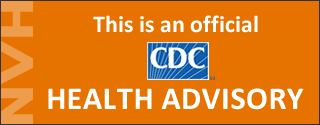Outbreak of Pneumonia of Unknown Etiology (PUE) in Wuhan, China
Distributed via the CDC Health Alert Network
January 8, 2020, 1615 ET (04:15 PM ET)
CDCHAN-00424
Summary
The Centers for Disease Control and Prevention (CDC) is closely monitoring a reported cluster of pneumonia of unknown etiology (PUE) with possible epidemiologic links to a large wholesale fish and live animal market in Wuhan City, Hubei Province, China. An outbreak investigation by local officials is ongoing in China; the World Health Organization (WHO) is the lead international public health agency. Currently, there are no known U.S. cases nor have cases been reported in countries other than China. CDC has established an Incident Management Structure to optimize domestic and international coordination if additional public health actions are required.
This HAN Advisory informs state and local health departments and health care providers about this outbreak and requests that health care providers ask patients with severe respiratory disease about travel history to Wuhan City. Wuhan City is a major transportation hub about 700 miles south of Beijing with a population of more than 11 million people.
Background
According to a report from the Wuhan Municipal Health Commission, as of January 5, 2020, the national authorities in China have reported 59 patients with PUE to WHO. The patients had symptom onset dates from December 12 through December 29, 2019. Patients involved in the cluster reportedly have had fever, dyspnea, and bilateral lung infiltrates on chest radiograph. Of the 59 cases, seven are critically ill, and the remaining patients are in stable condition. No deaths have been reported and no health care providers have been reported to be ill. The Wuhan Municipal Health Commission has not reported human-to-human transmission.
Reports indicate that some of the patients were vendors at the Wuhan South China Seafood City (South China Seafood Wholesale Market) where, in addition to seafood, chickens, bats, marmots, and other wild animals are sold, suggesting a possible zoonotic origin to the outbreak. The market has been closed for cleaning and disinfection. Local authorities have reported negative laboratory test results for seasonal influenza, avian influenza, adenovirus, severe acute respiratory syndrome-associated coronavirus (SARS-CoV), and Middle East respiratory syndrome coronavirus (MERS-CoV) among patients associated with this cluster. Additional laboratory testing is ongoing to determine the source of the outbreak. Health authorities are monitoring more than 150 contacts of patients for illness.
CDC has issued a level 1 travel notice (“practice usual precautions”) for this destination. (https://wwwnc.cdc.gov/travel/notices/watch/pneumonia-china). On January 5, 2020, WHO posted an update on this situation, including an early risk assessment, which is available at: https://www.who.int/csr/don/05-january-2020-pneumonia-of-unkown-cause-china/en/.
Recommendations for Health Care Providers
- Providers should consider pneumonia related to the cluster for patients with severe respiratory symptoms who traveled to Wuhan since December 1, 2019 and had onset of illness within two weeks of returning, and who do not have another known diagnosis that would explain their illness. Providers should notify infection control personnel and local and state health departments immediately if any patients meet these criteria. State health departments should notify CDC after identifying a case under investigation by calling CDC’s Emergency Operations Center at (770) 488-7100.
- Multiple respiratory tract specimens should be collected from persons with infections suspected to be associated with this cluster, including nasopharyngeal, nasal, and throat swabs. Patients with severe respiratory disease also should have lower respiratory tract specimens collected, if possible. Consider saving urine, stool, serum, and respiratory pathology specimens if available.
- Although the etiology and transmissibility have yet to be determined, and to date, no human-to-human transmission has been reported and no health care providers have been reported ill, CDC currently recommends a cautious approach to symptomatic patients with a history of travel to Wuhan City. Such patients should be asked to wear a surgical mask as soon as they are identified and be evaluated in a private room with the door closed. Personnel entering the room to evaluate the patient should use contact precautions and wear an N95 disposable facepiece respirator. For patients admitted for inpatient care, contact and airborne isolation precautions, in addition to standard precautions, are recommended until further information becomes available. For additional information see: https://www.cdc.gov/infectioncontrol/guidelines/isolation/index.html.
This guidance will be updated as more information becomes available.
For More Information
1-800-CDC-INFO
https://www.cdc.gov/cdc-info/index.html
CDC’s Emergency Operations Center: 770-488-7100
The Centers for Disease Control and Prevention (CDC) protects people’s health and safety by preventing and controlling diseases and injuries; enhances health decisions by providing credible information on critical health issues; and promotes healthy living through strong partnerships with local, national and international organizations.
Department of Health and Human Services
HAN Message Types
- Health Alert: Conveys the highest level of importance about a public health incident.
- Health Advisory: Provides important information about a public health incident.
- Health Update: Provides updated information about a public health incident.
###
This message was distributed to state and local health officers, state and local epidemiologists, state and local laboratory directors, public information officers, HAN coordinators, and clinician organizations.
###

